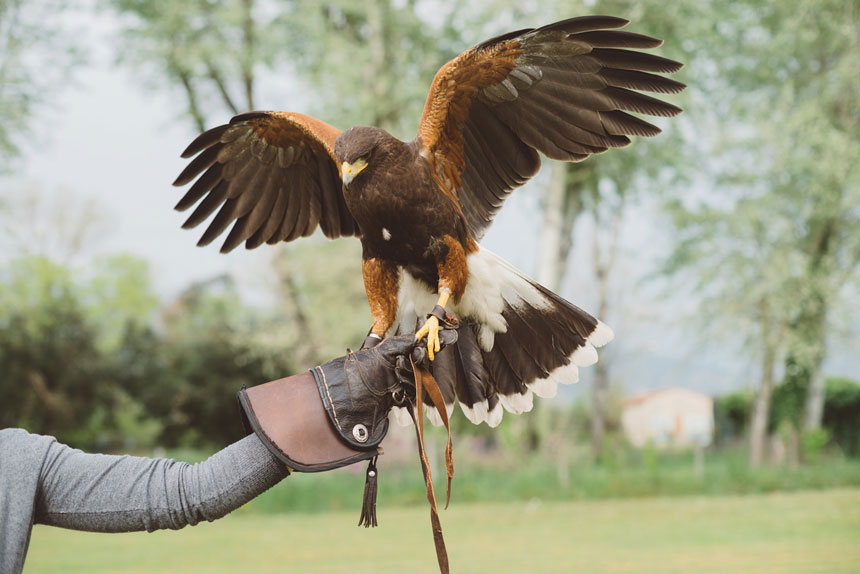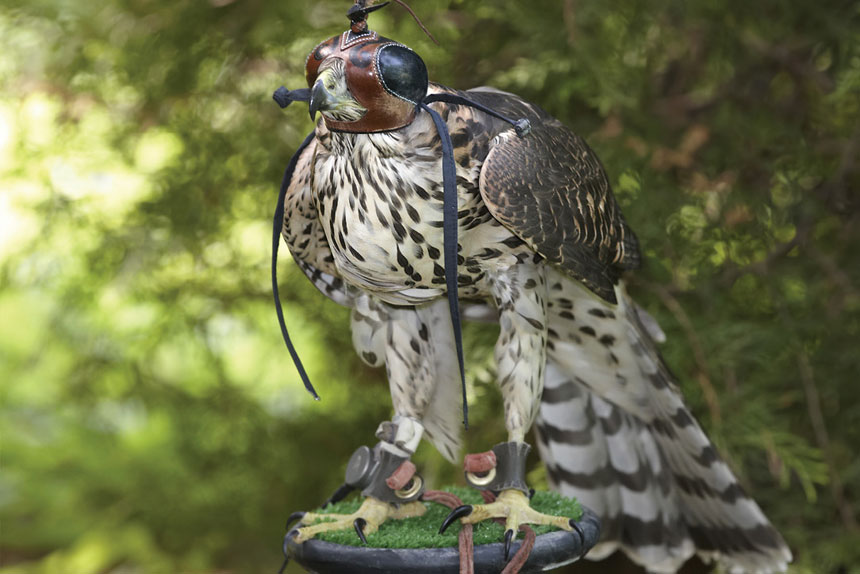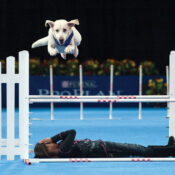Many years ago, when my marriage was still young — but I thought we already knew the big things about each other — I discovered that I had married a falconer. He burst into the house one day with a large brown paper bag in his hand and started babbling about preparing a hawk house and getting a New York State falconry license. I stopped him and said, “What are you talking about?”
“I’m a falconer,” he said, and then added, “I just haven’t had a bird in a while.” He opened the bag and in it was an American kestrel, the smallest falcon in North America, that a raptor rehabilitator had given to him to care for. After my shock of the bird-in-the-bag, I began to ponder the bigger questions. What the heck is a falconer? And who is this man I married? (As it turned out, Tim had become interested in falconry as a 12-year-old and had been a master falconer in California for at least a couple of decades before we met.)

Falconry is an ancient sport with roots in Central Asia and the Middle East. Most of us can conjure up images of falconers: Arab sheiks with magnificent birds on their fists; medieval noblemen (and noblewomen) carrying hooded falcons; 18th-century Englishmen, readying their peregrines for the hunt. Often called the “Sport of Kings,” falconry has usually been regarded as a distinctly upper-class activity — though that wasn’t always so. There were many yeoman falconers in the Middle Ages, who usually flew goshawks, which they used to fill their larders with rabbits, partridges, and other desirable game.
In the United States, falconry developed in the early 20th century and was a largely egalitarian sport right from the start. There were plenty of places to hunt — not just in private estates and moorlands like Europe but in wide-open public lands where anyone could hunt freely. And it had — and still has — such a wide variety of game, including waterfowl, grouse, partridge, pheasants, doves, jackrabbits, cottontails, and squirrels.
The term falconry is somewhat of a catch-all term. The sport doesn’t just involve true falcons, such as gyrfalcons, peregrines, prairie falcons, merlins, and kestrels, but also eagles, goshawks, red-tailed hawks, and many others. Flying a bird of prey — whether it’s a falcon, an eagle, or a hawk — is also called hawking. A falconer often chooses the bird to fly based on the available prey species. Red-tailed hawks (a large soaring hawk in the genus Buteo) are routinely used for hunting rabbits and squirrels; peregrine falcons — once called duck hawks — are usually flown at grouse, pheasants, or waterfowl; merlins and kestrels are flown at small birds; Cooper’s hawks and goshawks (woodland hawks of the genus Accipter) catch birds and rabbits.
If you’ve ever been to a bird or raptor show at a zoo or resort, you’ve probably seen a falconer with a raptor perched on a leather-gloved hand. The falconer holds the gloved arm aloft for the bird to fly from and return to.
The birds are trained to come back to the falconer’s fist when called, often with a whistle, and are then rewarded with food.
Many people become captivated by these magnificent birds once they’ve seen them in action, and some decide they’d like to try falconry, but they are usually discouraged when they find out how highly regulated the sport is. Although hawks were once perceived as pests and chicken killers that should be exterminated, by the mid-20th century American attitudes toward them began changing. At Hawk Mountain, the famous bird sanctuary in Pennsylvania, people used to line up shoulder to shoulder along the mountain ridge to shoot migrating birds of prey for sport. Now, in the U.S., raptors are protected under numerous laws, including the Migratory Bird Treaty Act (1918), CITES (1973), and the Endangered Species Act (1973).
Many older falconers came to the sport as kids after coming across a National Geographic article written by artist Louis Agassiz Fuertes in 1920 or two articles in the same publication written by twin brothers John and Frank Craighead in 1937 and 1941 that grabbed their imaginations and never let go. Or they happened to see a falconer fly a bird. Or they saw the flight of a wild peregrine, circling high in the sky and then plummeting earthward with wings folded against its body in a colossal power-dive (called a stoop) as it tried to strike its prey and knock it senseless. Whatever the spark, it began years of training birds and seeking out people like themselves who can trade stories for hours about training methods and the flights of birds they flew in the past.
Falconers represent a tiny fraction of the hunters in North America, numbering in the low thousands. Within this small subculture, the falconers who specialize in flying true falcons, such as gyrfalcons and peregrines, might be a quarter of that number or less.
The North American Falconers Association (NAFA), founded in 1961, is the largest falconry club in the Western Hemisphere. The group’s annual field meets — generally held during the week of Thanksgiving — attract hundreds of participants who come to fly their birds, watch other people go hawking, and talk with each other for hours on end. Many states and provinces have their own falconry clubs that also hold field meets — some, such as the California Hawking Club meets, rivaling NAFA in attendance.
In the United States, birds of prey — including hawks, falcons, eagles, and owls — are federally protected species. The federal government has given states the authority to regulate falconry. The state regulations must be just as strict as the federal regulations; however, in some states, they are even more strict.
Where I live, in New York State, if you want to become a falconer, you must first take a written exam administered by New York’s Department of Environmental Conservation, then build a structure to house your bird and have it inspected. Then, you must serve an apprenticeship under a sponsor who must be a licensed General or Master Falconer. Under the guidance of your sponsor, you can trap, train, and hunt with an immature red-tailed hawk or a kestrel (the only two species an apprentice can work with). After two years, and if approved by your sponsor and the state agency, an apprentice becomes a General Falconer, and five years after that (if you get approved by the state), you can become a Master Falconer. (As a friend pointed out to me, that’s the same amount of time it takes to become a doctor.)
Falconers must have a valid state hunting license and, if hunting waterfowl, a federal duck stamp. States determine the falconry hunting seasons. If caught in a field without a falconry license or hunting out of season, falconers risk having their bird confiscated by a game warden, an outcome no one wants.


Falconry is all about the relationship and trust between a person and a bird. Except for Harris’s hawks, raptors are solitary creatures. They don’t spend time together or hunt in groups, so the falconer is attempting to do something that does not come naturally to these birds. Hawks don’t want to be your friend. They don’t seek to win your approval. They will never be motivated by punishment or mistreatment. They are not pets. Your goal as a falconer is to be seen by your bird as a hunting partner. You are the one who flushes the game, providing opportunities for the bird that would not be available without you. And if the bird fails to make a kill, you can still feed it upon its return.
Falconers work closely with a new bird for weeks, teaching it to fly back to them and also to allow them to approach it on a kill. Most falconers teach their birds to accept wearing a leather hood, which calms it down immediately. Hooding a bird is not easy and relies on a smooth and steady hand. Over time, the bird becomes accustomed to being on the falconer’s fist or on a perch, or riding in a vehicle to a hunting field.
Many of the training techniques used today are the same as those described by the 13th-century Holy Roman Emperor Frederick II, who wrote De Arte Venandi cum Avibus (“On the Art of Hunting with Birds”). And falconry is littered with words and terms from earlier times, such as haggard, cadger, jerkin, and fed up.
Eventually the falconer introduces the bird to the lure — a leather pouch swung over the falconer’s head to attract the bird’s attention. In a perfect world, once the falconer swings the lure, it signals the hawk to come to the lure and be rewarded with food.
The scariest time of a bird’s training is when the falconer decides the bird is ready to fly free. Nothing but trust keeps the bird tethered to the falconer. A tiny transmitter is attached to one of the bird’s tail feathers (or to its leg) before it flies in a field; this way, if the bird does decide to chase something up and over the next hill, the falconer can track the transmitter’s signal with a receiver. Some high-tech transmitters can also send GPS information about the bird’s flight that you can follow on a smartphone. For centuries, falconers had only bells to help them find their birds, and some modern falconers still attach bells to a bird’s legs, making it easier to find them if they catch prey in some brush or other cover. But the radio transmitters they use now, which have been around since the 1970s, are like high-tech bells.
In the closed-in, wooded landscape of the Northeast, it’s much more common to find falconers flying red-tailed hawks, which crash through the trees after gray squirrels; or accipiters, such as Cooper’s hawks or goshawks, woodland raptors that are lightning-fast masters of the sneak attack. Flying falcons requires large, open tracts of land to fly well. They are typically flown from a “waiting on” position, circling hundreds of feet above the falconer, waiting for game to be flushed. This is the allure of the American West for falconers — miles of open land and lots of game.

When my husband’s falconry urge came out of remission, he re-entered the sport with the kind of enthusiasm reserved for kids the day before Christmas. We had three children at the time — two of them toddlers — and Daddy’s Little Bird, as it was named by a three-year-old, lived in a mews built around a dormer window in the high-ceilinged attic of our Victorian home. Over a couple of decades, five different birds — the kestrel, two merlins, and two peregrines — lived in the attic, and Tim eagerly looked forward to hunting season every autumn. When the kids were young, they would accompany him to the field on weekends and run amok like puppies as he flew his bird. He would head out alone on weekdays before going to work. For years we had falcon-caught ducks in the freezer, which we’d share at our big family Thanksgiving gathering.
Seeing Tim in the field with a bird was watching someone instantly process an enormous amount of information. Which way was the wind blowing and how fast? Were there birds flying overhead that could distract the falcon? Were there ducks to flush from the pond? Were there any predators around like an eagle or another falcon that might put his bird in danger? And I knew in the back of his mind he was always picturing the things that could go wrong and figuring out what he would do to prevent it, thinking, Will this be the day my bird flies off and I won’t be able to find him?
Over the years, I came to understand falconry as an obsession that held falconers captive and was not to be trifled with by outsiders. They couldn’t help it. The birds came before wives and girlfriends. During hunting season, I accepted that I was a “falconry widow.” Although I was not keen about the hunting part of falconry, I also realized the odds of a duck escaping a falcon’s talons was much greater than a duck trying to dodge a bullet from a gun. Ducks had evolved side-by-side with falcons for millennia.
What’s in it for the bird? Regular meals, for one thing. During their first year, up to 90 percent of young raptors in the wild can die, often of starvation. Wild-trapped hawks are often released back into the wild as seasoned hunters after serving as falconry birds for a year or two, giving them a much greater chance of survival.
In the 1960s, peregrine falcons rapidly disappeared from the United States due to disastrous effects from the pesticide DDT (which was banned in 1972). Falconers from around the country donated their peregrines to a captive-breeding program housed at Cornell University that was part of a decades-long experiment to reintroduce these birds. Wildly successful, there are now more peregrines in the United States than there were historically, nesting on buildings, bridges, and cliffs.
Falconry is a passionate pursuit for the truly obsessed, and for those of us fortunate enough to witness the flights of falcons, time collapses as the birds ring up higher and higher into the sky, and we wait for them to select their prey and then fold their wings and plummet toward earth at speeds of over 200 mph. You can hear the wind whistling through the feathers as it nears, and we hold our breath.
For more information, visit the North American Falconers Association at n-a-f-a.com.
Rachel Dickinson is the author of seven nonfiction books, including Falconer on the Edge: A Man, His Birds, and the Vanishing Landscape of the American West and a memoir in essays The Loneliest Places: Loss, Grief, and the Long Journey Home. Her work has been published in many publications, including The Atlantic, Audubon, and The Saturday Evening Post.
This article is featured in the July/August 2024 issue of The Saturday Evening Post. Subscribe to the magazine for more art, inspiring stories, fiction, humor, and features from our archives.
Become a Saturday Evening Post member and enjoy unlimited access. Subscribe now




Comments
I hate birds! I find them repulsive!! Please do not send any issue filled w/up-close photos of birds!!! If my fiance had ever brought me a bird-in-a-bag it would have instantly and completely ended our romance!!!!
My earliest memory when I was maybe all of 2 yrs old was of my mother screaming while throwing a teacup that shattered at my father who came into our apt w/the feet of a dead chicken sticking out of a grocery bag. This was so traumatic that I can still hear, and will probably go to my grave decades later, w/ that scene stuck in my head.
As a teen, when I applied for a summer job at the Cleveland Zoo thinking I could enjoy children petting furry animals like seals, lion cubs, or even handling snakes, the director, after asking if I was afraid of any animals, informed me that the fear of birds is more common than most people know. “Maybe those reptilian feet?”he guessed. Small comfort to me. Then he politely dismissed me. I earned my first job picking apples in a high tree by a dirty railroad track and strawberries crawling on beds of straw. But spare me your your romantic look at falconry…I’ll glue those pages together.